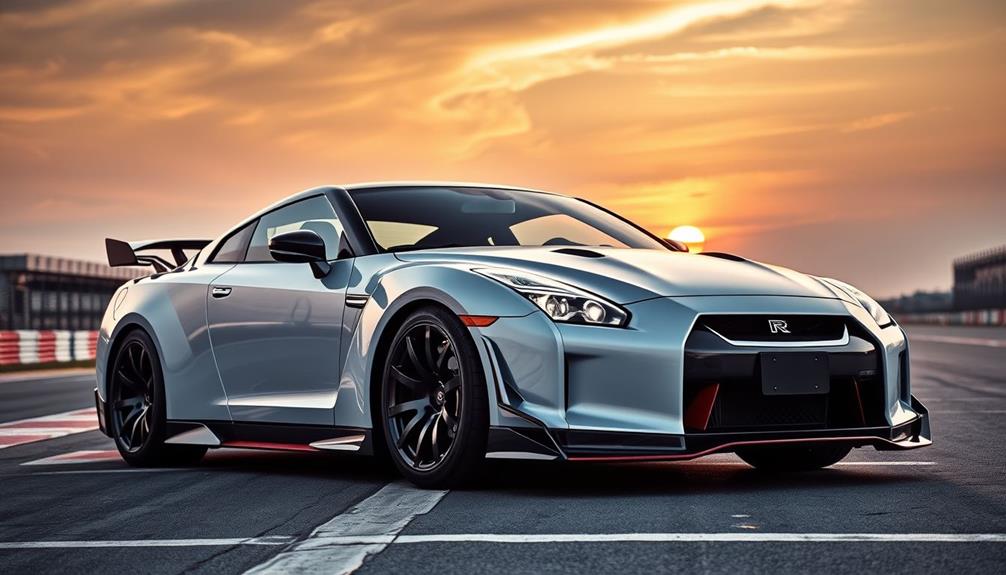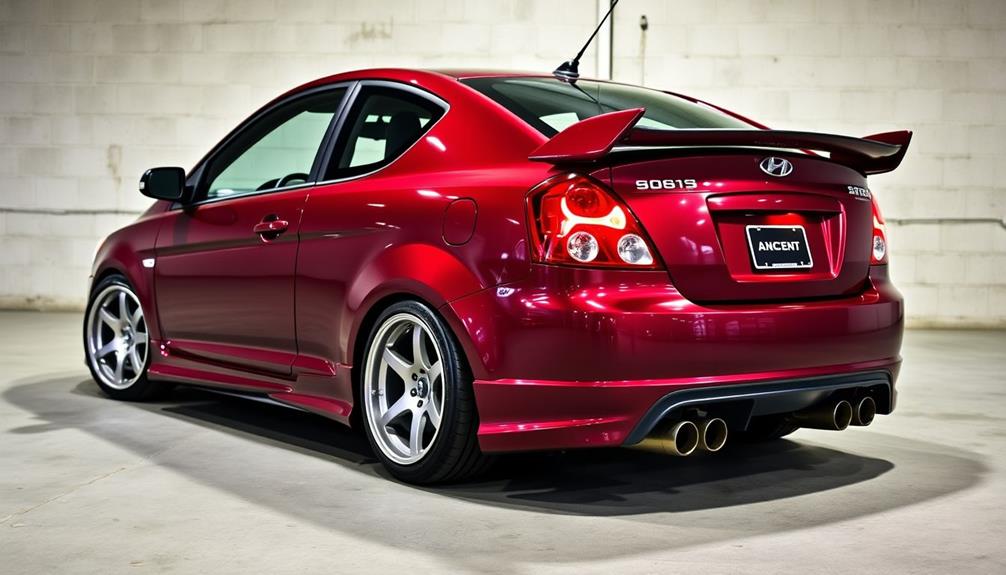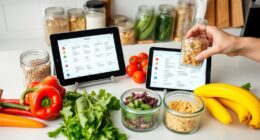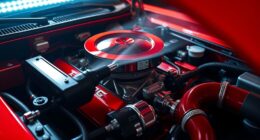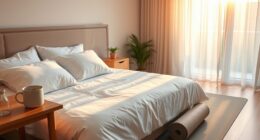Tuning your Hyundai Ioniq can greatly boost its performance and bring modern power to your hybrid or EV. By opting for aftermarket modifications like ECU remapping, you can enhance throttle response and overall motor efficiency. Consider a motor swap for an increase to 204 horsepower, though be mindful of the potential warranty implications. It's essential to understand the power demands your Ioniq faces, particularly the challenges with current handling and traction. Proper upgrades will mitigate risks of mechanical failures. Stick around for insights on maximizing your Ioniq's capabilities while keeping it safe and efficient.
Key Takeaways
- ECU remapping enhances throttle response and overall motor performance, providing a straightforward tuning option for the Ioniq.
- Motor swaps, such as replacing the Ioniq's motor with the Kona's, can boost horsepower to 204.
- Aftermarket modifications may void warranties, so consider potential repair costs before proceeding with tuning.
- Traction limitations in FWD setups necessitate effective power management to prevent wheel spin during acceleration.
- Upgrading components, including cables and motor windings, is essential for handling increased power demands safely.
Tuning Options Overview
When considering tuning options for your Hyundai Ioniq, you'll find a variety of aftermarket modifications that can greatly enhance performance. One popular choice is ECU remapping, which boosts throttle response and overall motor performance. This can greatly improve your driving experience, giving you a more responsive vehicle while maintaining your miles of range.
For those looking for a serious power upgrade, consider motor swaps. By replacing the Ioniq's motor with the Kona's, you could tap into 204 horsepower, a substantial bump over the standard output. However, it's important to keep in mind that such tuning options may impact your warranty coverage. You need to weigh the benefits against the potential risks.
High power outputs can lead to traction and handling issues, especially with the Ioniq's front-wheel-drive setup. It's important to approach these modifications thoughtfully.
Discussions in the enthusiast community reveal mixed opinions on feasibility, with concerns about mechanical failures and electrical system stress. Ultimately, while tuning options can enhance your Hyundai Ioniq, careful consideration and thorough research are crucial to guarantee you make the best choices for performance and reliability.
Understanding Power Demands

Understanding the power demands of your Hyundai Ioniq is essential if you're considering tuning options. Electric motors can require up to 10 times their nominal power during startup, which means your electrical components need to be robust enough to handle these spikes. The Ioniq's battery capabilities, rated at 2.6C, indicate a lower performance threshold compared to competitors, affecting overall power delivery and responsiveness.
When tuning, increasing the peak power output by just 20% necessitates corresponding increases in current. This can lead to motor winding failures if not properly managed. Every component in the power chain must be appropriately sized to accommodate these higher current levels.
Additionally, keep in mind that high power outputs can exacerbate traction issues in front-wheel drive vehicles like the Ioniq. This makes it challenging to effectively transfer increased power to the ground during acceleration. Here's a quick overview of power demands and potential issues:
| Power Output Increase | Component Requirement | Traction Impact |
|---|---|---|
| 10% | Minor upgrades | Minimal |
| 20% | Moderate upgrades | Noticeable |
| 30% | Significant upgrades | Major issues |
Key Engineering Considerations

When tuning your Hyundai Ioniq, you need to take into account the motor ratings and dynamics to guarantee peak performance.
Proper sizing of power chain components is essential, as even a 20% increase in output demands more current, which can strain existing parts.
Additionally, be mindful of the current handling limitations, since exceeding these can lead to failures and affect your vehicle's overall stability.
Motor Ratings and Dynamics
Electric motor ratings and dynamics play an essential role in the performance and reliability of the Hyundai Ioniq, especially when considering tuning options. Understanding these ratings is vital if you want to enhance your vehicle's capabilities.
Factors like winding thickness and heat dissipation directly impact your motor's ability to handle increased power output.
If you're thinking about boosting the Ioniq's peak power output by 20%, keep in mind that this requires a proportional increase in current handling across all components. The Ioniq's motor has a battery capability of only 2.6C, which is less than Tesla's 5-6C, indicating it's designed for less aggressive power demands.
Going beyond this can lead to serious risks, like motor winding failure and overheating.
High-performance modifications should always consider the existing design margins of the Ioniq. If you push these limits, you may compromise the reliability and longevity of your vehicle.
Power Chain Components Sizing
Tuning the Hyundai Ioniq's power chain components is fundamental for achieving reliable performance enhancements. When you increase the peak power output of the electric motor by 20%, you also need to boost the current, which can push existing components beyond their limits. Upgrading winding thickness and heat dissipation capabilities is essential to avoiding motor failure.
Confirming all elements in the power chain, like cables and connectors, are rated for the increased loads helps prevent overheating and failures. The Ioniq's battery, rated at 2.6C, highlights the limitations compared to higher-performance EVs, making careful consideration critical in any performance modifications.
Here's a quick reference table for sizing your power chain components:
| Component | Recommended Size |
|---|---|
| Electric Motor | Upgrade winding |
| Battery | 2.6C rating |
| Cables/Connectors | Higher gauge wire |
Ultimately, existing design margins may limit safe modifications, so assess the risk of motor winding failure when increasing power output. Stay within these guidelines to secure peak performance without compromising reliability.
Current Handling Limitations
Upgrading the power chain components of the Hyundai Ioniq is just the beginning; current handling limitations present considerable engineering challenges that need addressing.
Electric motors, like those in your Ioniq, demand notably higher power during startup—up to 10 times their nominal usage. This means that if you're considering performance modifications, you must enhance the entire power chain to handle increased current demands effectively.
Increasing the Ioniq's peak power output by even 20% requires careful engineering to prevent motor winding failures and maintain system integrity. The thickness of the motor windings directly impacts their ability to dissipate heat, making any tweaks potentially risky.
Existing design margins already limit safe modifications, and pushing performance beyond these limits can lead to mechanical failures due to inadequate component sizing for higher currents.
Furthermore, the Ioniq's front-wheel-drive configuration is particularly vulnerable to traction issues when power outputs rise markedly, which could result in loss of control during acceleration.
To navigate these challenges, you'll need a thorough understanding of current handling limitations so you can make informed decisions that balance performance with reliability.
Performance Challenges to Address

When tuning your Hyundai Ioniq, you'll likely face traction limitations due to its front-wheel drive setup, especially if you're upping the power.
This can make it tough to transfer that added power to the ground during acceleration.
Additionally, increasing your motor's output raises the risk of winding failure, so you'll need to tread carefully with your modifications.
Traction Limitations in FWD
Front-wheel drive (FWD) vehicles like the Hyundai Ioniq face significant traction challenges, especially when high power outputs are involved. The Ioniq's design focuses on efficiency rather than performance, which can exacerbate traction issues when you're trying to harness increased motor power. This can lead to wheel spin during hard acceleration, particularly in adverse weather conditions.
To help you better understand these challenges, here's a quick comparison of FWD configurations and their traction limitations:
| Aspect | FWD Configurations |
|---|---|
| Traction Control | Essential for managing power |
| Performance Upgrades | Can hinder traction without mods |
| Wheel Spin Potential | High under hard acceleration |
| Control Loss | Risk increases in poor conditions |
| Tuning Needs | Critical for optimizing power |
Addressing these traction limitations is important for maximizing your Ioniq's performance. Effective power management and robust traction control systems are essential to mitigate traction loss during acceleration, ensuring you can enjoy those performance upgrades without compromising control and safety.
Power Transfer Difficulties
Power transfer difficulties are a significant hurdle for Hyundai Ioniq owners aiming to boost performance. The Ioniq's front-wheel drive (FWD) system can struggle to effectively transfer increased power to the ground, which often results in traction issues during rapid acceleration.
When you push for more power, electric motors may demand up to ten times their nominal power at startup. This means you'll need larger components to handle that surge without overheating.
If you're aiming for a 20% increase in peak power, be aware that all components in the power chain will require enhanced current handling. This raises the risk of mechanical failures, which could lead to costly repairs and downtime.
In addition, high power outputs can exacerbate loss of control, especially in adverse conditions, showcasing the Ioniq's limitations compared to high-performance vehicles.
Existing design margins may also limit the feasibility of safe performance modifications, putting you at risk of not just power transfer difficulties but also potential motor winding failures.
Motor Winding Risks
Motor winding failures often become a pressing concern for those tuning their Hyundai Ioniq for higher performance. When you increase the peak power output by 20%, you also need to boost current handling, which can lead to overheating and potential failures. The risk escalates as you modify the windings; thicker windings and improved heat dissipation are necessary to manage the increased stress on the motor.
During performance tuning, electric motors like the Ioniq's face significant thermal stress at high power levels. If you don't manage this correctly, it can drastically reduce the lifespan of the motor. Existing design margins may limit how far you can push these modifications without risking mechanical failure or reduced efficiency.
To avoid overheating, you'll likely need to upgrade cables and power systems to handle the high current demands associated with your tuning ambitions.
Community Insights on Tuning

Enthusiasts often share a range of insights on tuning the Hyundai Ioniq, revealing a mix of excitement and caution. Many members of the community highlight the potential performance upgrades available through remapping the ECU to enhance throttle response.
However, they also raise valid concerns about warranty implications. Modifications might void your warranty, leaving you with costly repairs if things go wrong.
While some users report significant gains in performance, others caution that tuning can lead to mechanical risks, such as motor winding failure due to increased current demands. It's crucial to weigh these risks carefully before diving into any tuning project.
Community discussions also emphasize the Ioniq's traction limitations, especially in front-wheel-drive configurations. High-performance upgrades might be tempting, but they can exacerbate traction issues, leading to a less enjoyable driving experience.
Anecdotal experiences shared by members reveal a spectrum of successes and failures with performance upgrades in other EVs, underscoring the need for a thoughtful approach when modifying the Ioniq.
Ultimately, staying informed and cautious can help you navigate the tuning process while minimizing potential downsides.
Effective Range Maximization Tips

Maximizing the range of your Hyundai Ioniq is essential for enjoying longer drives without frequent charging stops. Here are some effective tips to help you get the most out of your hybrid or EV.
| Tip | Benefit | Frequency |
|---|---|---|
| Check tire pressure | Increases efficiency by reducing drag | Weekly |
| Precondition the cabin | Saves battery for driving | Before trips |
| Optimize driving behavior | Smooth acceleration improves range | Always |
| Utilize regenerative braking | Recaptures energy during urban driving | Every trip |
| Remove unnecessary cargo | Reduces weight and drag for better range | Monthly |
Regularly check and maintain your tire pressure, as underinflated tires can reduce efficiency by up to 3% for every 1 PSI drop. Also, consider preconditioning the cabin while plugged in to avoid using battery power on climate control. Focus on optimizing your driving behavior—accelerate smoothly and maintain a steady speed. Finally, remove unnecessary cargo and accessories that add weight, as this can adversely affect your range. By following these tips, you'll enjoy longer journeys in your Hyundai Ioniq with confidence.
Frequently Asked Questions
Why Did They Stop Making Hyundai Ioniq Hybrid?
They stopped making the Hyundai Ioniq Hybrid because consumer preferences shifted towards fully electric vehicles. Sales declined, and Hyundai wanted to focus on expanding its electric lineup, enhancing sustainability, and investing in future battery technologies.
Does Ioniq Hybrid Have EV Mode?
Yes, the Ioniq Hybrid does have an EV mode. You can drive solely on electric power at low speeds, enhancing efficiency while steering through city traffic. Just keep an eye on the dashboard for real-time feedback.
What Is the Power of Hyundai Ioniq Hybrid?
The Hyundai Ioniq Hybrid delivers a combined output of 139 horsepower and 195 lb-ft of torque. This efficient powertrain seamlessly switches between electric and gasoline, ensuring you get peak performance for your driving needs.
What Is the Powertrain of Ioniq Hybrid?
Imagine gliding effortlessly on the road. The Ioniq Hybrid's powertrain combines a 1.6-liter GDI engine and a 32 kW electric motor, delivering 139 horsepower, while a seamless dual-clutch transmission optimizes your driving experience.
Conclusion
Tuning your Hyundai Ioniq isn't just about boosting power; it's like tuning a musical instrument for the perfect harmony. Just as a skilled musician adjusts strings to create beautiful melodies, you can fine-tune your hybrid or EV to release its full potential. With the right adjustments, your ride can transform from a gentle hum to a thrilling crescendo. Embrace the journey of tuning, and watch your Ioniq hit new notes of performance and efficiency. Whether you’re looking for subtle enhancements or bold upgrades, the possibilities are endless. From optimizing energy regeneration settings to adjusting throttle response, each tweak contributes to a more refined and exhilarating driving experience. For those also exploring Hyundai Genesis tuning ideas, you’ll find that precision upgrades are key to unlocking both vehicles’ latent power while maintaining efficiency.

